Best SSDs 2024: From Budget SATA to Blazing-Fast NVMe
Based on our extensive tests, these are best SSDs for every need and budget.
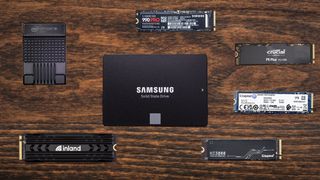
Of the key components in any PC, the storage drive is the slowest: transferring bits in a fraction of the time your CPU and GPU take to process it or your RAM takes to load it. A poor-performing storage drive often leads to a big bottleneck, forcing your processor (even if it's one of the best CPUs for gaming) to waste clock cycles as it waits for data to crunch.
Finding the best SSD or solid-state drive for your specific system and needs is key if you want the best gaming PC or laptop, or even if you just want a snappy productivity machine. To find the best SSDs for gaming and productivity, we test dozens of drives each year and highlight the best ones here. We have multiple categories, including the best SSD for NAS and the Best SSD for the Steam Deck listed below. For those on the hunt for the best SSD for the PS5, be sure to head to that link for our recommendations based on our exhaustive testing. If you're looking for the ultimate in cheap and deep storage, we also have a list of the best hard drives.
Picking the Best SSD for You
Why you can trust Tom's Hardware
The newest budget NVMe SSDs have undercut the pricing of mainstream drives on the slower SATA interface (which was originally designed for hard drives), but we shouldn't expect to see the end of SATA SSDs any time soon.
The era of PCIe 5.0 SSDs is upon us, propelling us to new heights of stratospheric SSD performance. Blazing-fast PCIe 5.0 M.2 SSDs, which offer up to twice the sequential speeds of the older PCIe 4.0 standard, are now supported with Intel and AMD's current platforms, like Zen 4 Ryzen 7000 and 14th-Gen Raptor Lake Refresh.
It's great if your desktop system can handle a PCIe 5.0 drive, but they are still new and more expensive, so they aren't a requirement. For example, the PCIe 4.0 Samsung 990 Pro is our current choice for the best SSD overall, and the best SSD for gaming. This drive is rated for 7,450 / 6,900 MBps of sequential read/write throughput and 1.2 / 1.55 million read/write IOPS. That means less time waiting for game levels to load or videos to transcode, not to mention a snappier experience in Windows.
PCIe 5.0 SSDs still have plenty to offer. The Crucial T705 is unquestionably the fastest consumer SSD in the world that you can actually buy, at least for now, delivering up to a blistering 14.5 GB/s of sequential throughput and 1.8 million random IOPS over the PCIe 5.0 interface. That's an amazing level of performance from an amazingly compact device.
While the PCIe 5.0 drives are the fastest SSDs money can buy right now, believe it or not, raw speed isn't everything. In regular desktop tasks such as web browsing or light desktop work, you may not even notice the difference between a PCIe 3.0 SSD and one with a 4.0 interface, let alone a new bleeding-edge PCIe 5.0 model. The latest PCIe 5.0 SSDs also carry a heavy price premium for now, so you're probably best suited with a PCIe 4.0 model — unless you're after the fastest possible performance money can buy, of course. If that's the case and your system supports it, go for a new PCIe 5.0 SSD.
Ultimately, the best SSD for you is one that provides enough capacity to hold your data at a price you can afford. Consider that a high-end, AAA game can use more than 100GB of data, and Windows 11 all by itself may need 60GB.
Best SSDs in 2024 at a glance (more info below):
| Best SSDs | Best SSD | Alternate |
|---|---|---|
| Best Overall / Best M.2 SSD | Samsung 990 Pro | WD Black SN850X |
| Fastest SSD | Crucial T705 | Crucial T700 |
| Best M.2 SSD for Laptops | SK hynix Gold P31 | Teamgoup MP44 |
| Best Budget M.2 SSD | Crucial P3 | Row 3 - Cell 2 |
| Best SSD for PS5 | Inland Gaming Performance Plus | Row 4 - Cell 2 |
| Best SSD for Steam Deck, Mobile | Sabrent Rocket 2230 | Row 5 - Cell 2 |
Here's the shortlist of our rankings, but we have deeper breakdowns for these drives below, along with far more picks for other categories, like PS5 SSDs, RGB SSDs, workstation SSDs, and SATA SSDs, among other categories.
Quick Shopping Tips
- Pick a compatible interface (M.2 PCIe, SATA, Add-in Card): Look at your user manual or a database like the Crucial Memory Finder to determine what types of SSD your computer supports.
- 500GB to 2TB: 1TB is the practical minimum for any PC build that costs more than $500 (perhaps one of the best PC builds). 2TB is the best SSD capacity for anyone that can spend $200+ on a drive. 500GB is the bare minimum anyone should consider at any price. 4TB drives have also plummeted recently, so good deals abound.
- M.2 SSDs are the fastest: M.2 PCIe NVMe SSDs are the most common type of SSD on modern systems. These small, rectangular drives look like sticks of RAM, only smaller. They are usually 80mm long by 22mm wide, described as size 2280, but some may be shorter or longer, so make sure you get one that matches your slot.
- SATA is the slowest: SATA isn't as fast as an M.2 SSD, but the majority of desktops and many laptops support 2.5-inch SATA drives.
Below, you'll find our list of the best SSDs. For even more information, check out our SSD Buyer's Guide. Iif you're looking for an external SSD, you can check out our Best External Hard Drives and SSD page, or learn how to save some money by building your own external SSD.
Best SSDs You Can Buy Today

Specifications
Reasons to buy
Reasons to avoid
Samsung hit back at its competitors with this impressive update to the 980 Pro. New hardware and new options, including a heatsink with RGB and a 4TB variant, have allowed Samsung to retake the M.2 SSD crown. Performance is excellent across the board, setting a few new performance records, such as with 4K random read performance. In our testing, the drive was consistent, power-efficient, and cool. Samsung has also updated its software for this drive, giving it the best SSD toolbox available, and the drive is backed by a competent warranty and decent support.
$20 extra for a heatsink and RGB is a good deal, and Samsung will likely discount this drive over time. Competing PCIe 5.0 drives on the market offer faster performance, but they still carry a premium.
Read: Samsung 990 Pro Review
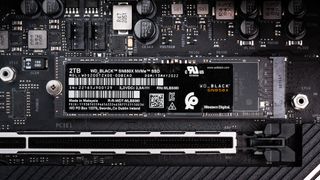
Specifications
Reasons to buy
Reasons to avoid
WD has taken its popular Black SN850 SSD and turned it up to 11. The Black SN850X leverages an improved controller and newer flash to get the most out of the PCIe 4.0 interface. Performance is improved across the board, and the drive rivals most of the top contenders in the PCIe 4.0 market. There's also a heatsink option that comes with RGB at 1TB and 2TB. WD also supports the SSD with its decent Dashboard application and a respectable five-year warranty.
The M.2 Black SN850X was a bit pricey at launch, however, with a daunting MSRP, but those prices have largely come down. The touted Game Mode 2.0 feature felt incomplete in our testing, although WD ensures us that this will improve with future firmware updates. All-in-all, this is a good compromise if you can’t find the Samsung 990 Pro.
Read: WD Black SN850X Review
Fastest Best SSDs 2024
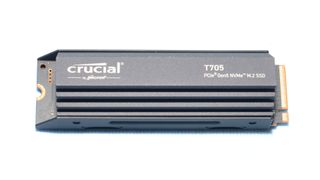
Specifications
Reasons to buy
Reasons to avoid
The Crucial T705 is the fastest drive we have tested to date, finally breaking the 14 GB/s barrier. Careful work with Phison’s Max14um reference SSD design has led Crucial to eke out even more performance, taking the excellent T700 - a previous Fastest SSD position holder - up a notch. The optional heatsink design remains passive, which is a bonus, and you can also purchase the drive bare. Aside from the solid sequential performance, the T705 also has good sustained performance and can reach an incredible 1,550K / 1,800K random read and write IOPS at 2TB.
This is the fastest drive for now, but there will be others. The Sabrent Rocket 5 is not too far behind, and there are drives built on non-Phison controllers - like the InnoGrit IG5666-based Teamgroup T-Force GE Pro - that also promise over 14 GB/s of potential throughput. PCIe 5.0 drives remain an enthusiast product due to cost and availability concerns, and so far, they have proven inefficient and unwise for laptops and the PS5. Still, if you want the fastest consumer storage you can buy, the T705 is the fastest drive on the market.
Read: Crucial T705 Review
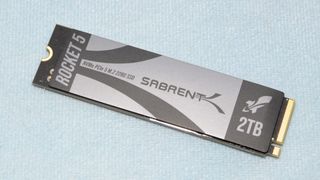
Specifications
Reasons to buy
Reasons to avoid
The Sabrent Rocket 5 has the distinction of providing the fastest direct-to-TLC write performance we have ever seen. During the longest of workloads, it can average write speeds of 4.45 GB/s, outclassing any PCIe 3.0 drive in existence and beating our previous high points with TLC flash with either 4.0 or 5.0 SSDs. It’s otherwise similar to other drives based on the Phison E26 controller, but it’s at the upper end of those, too. This allows it to provide excellent all-around performance with DirectStorage-optimized firmware for future-proofing.
It has the same downsides as other ultra-fast drives - namely, high power consumption and poor power efficiency. Idle power consumption in a desktop PC, which is the most likely destination for the drive, remains quite high. The Rocket 5 can also put out a lot of heat when it’s pushed. If you can provide an ample heatsink, though, this drive will run cool enough even under sustained workloads without any throttling. This makes it one of the fastest overall drives on the market, and the absolute fastest in extended heavy workloads.
Read: Sabrent Rocket 5 Review
Best 4TB SSD Alternative
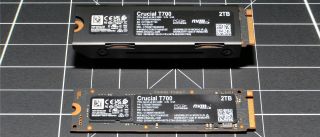
Specifications
Reasons to buy
Reasons to avoid
The Crucial T700 was the first 12 GB/s drive we reviewed, and it still remains one of the fastest drives we’ve ever tested. It’s also the first and only 4TB drive of its caliber that we tested. It’s been challenging to get 4TB of flash to maintain this level of performance, and 1TB isn’t enough to really get the most out of a Gen 5 SSD like this. That leaves 2TB as the only real solution, but there is a lot of demand for higher capacities as part of a storage upgrade. At this time, the T700 can best meet that role for PCIe 5.0 SSDs, given its relatively affordable price at the 4TB capacity.
The T700 won’t be the very fastest drive possible as we begin to see more 14+ GB/s options roll out. But it is still very fast, and faster than all Gen 4 and many Gen 5 SSDs. It has a nice passive heatsink option and the warranty you would expect, so no real compromises there. You’re paying a lot extra for the PCIe 5.0 bandwidth, though, but if you want a drive that will hang around a while - with its DirectStorage-optimized firmware - then the T700 is the best option. If you don’t need that much bandwidth, stick with the excellent Samsung 990 Pro for top 4TB performance.
Read: Crucial T700 4TB Review
Best Laptop SSDs 2024
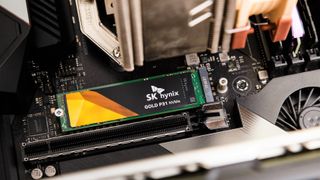
Specifications
Reasons to buy
Reasons to avoid
SK hynix’s Gold P31 touts market leadership as the first retail SSD product to launch with 128-Layer flash. With SK hynix’s newest flash reaching incredible bit density, the Gold P31 hits the market at very low pricing. Listed at competitive prices, the Gold P31 is a fantastic value that will make you think twice about spending that extra $25-$50 on the Samsung 970 EVO Plus.
SK hynix’s Gold P31 is great if you’re looking to increase your laptop storage, not only to gain capacity but to gain battery life, too. While some drives may perform well against the Gold P31 in benchmarking, the SK hynix is much more power-efficient, which will lead to longer off-the-charger sessions. Laptop users who prioritize battery life should definitely put the new SK hynix Gold P31 at the top of their drive list. Additionally, the Gold P31's very strong write performance and ultra-high efficiency make it a well-rounded choice for many desktop users as well.
Read: SK hynix Gold P31 Review
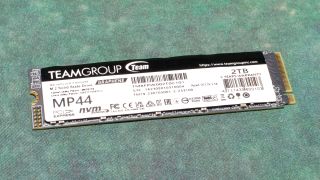
Specifications
Reasons to buy
Reasons to avoid
The Team MP44 is part of the vanguard for new and better DRAM-less SSDs. Newer controllers and flash are letting budget/value drives push the limits of the PCIe 4.0 interface while providing high capacities without making compromises. They can have the endurance and performance of TLC and the high power efficiency of four-channel, DRAM-less controllers, all without extra cost. Less power means less heat, and these drives are also designed to be single-sided. That combination makes the MP44 perfect for laptops.
The SK hynix Gold P31 is still the gold standard for laptop SSDs, especially as it has DRAM, but it’s limited to PCIe 3.0 bandwidth, isn’t always available, and is limited to 2TB of capacity. The MP44 can get twice the bandwidth, but even in a 3.0 slot, it is inexpensive for 4TB and even has an 8TB option. Other alternatives, like the Crucial P3 Plus or Corsair MP600 Core XT, are slower and use QLC. The heatsink found on the Addlink A93 and other SSDs preclude them from laptop use and can add a little cost. Otherwise, the MP44 will have some competition at lower capacities, but it is worth a look if you can find it at the right price.
Read: Teamgroup MP44 SSD Review
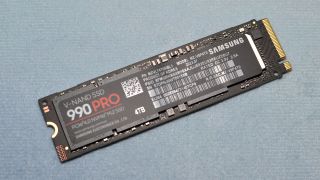
Specifications
Reasons to buy
Reasons to avoid
4TB has become a more attractive capacity point for SSDs as time has gone on. While there are now many options available, most come with compromises of one sort or another. You may have to settle for QLC, a weaker controller, no DRAM, unreliable hardware, etc. This is not always a big deal, especially if the drive is intended to be a secondary gaming drive. In the PlayStation 5, however, extra cooling is beneficial, so it’s convenient to have a heatsink option available. At the same time, laptops favor bare drives and especially single-sided drives, the latter of which have been very rare with TLC until recently.
Samsung has managed all of this with its high-performing 990 Pro SSD. You have a powerful controller with DRAM, cutting-edge TLC flash, and a single-sided drive with or without heatsink even at 4TB. WD’s SN850X has been out a while at 4TB but has no heatsink option and is double-sided, with the SN850P being a latter heatsinked version for the PS5. There has been an increasing amount of 4TB TLC drives, including the Lexar NM790 and Addlink A93, but these cannot compare to the power and brand power of Samsung’s 990 Pro. You do have to pay for that privilege given the high MSRP, but at this time there is no substitute.
Read: Samsung 990 Pro Review
Best Budget M.2 SSD 2024
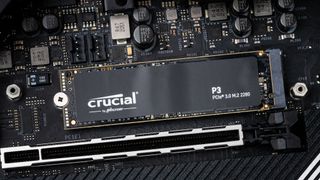
Specifications
Reasons to buy
Reasons to avoid
The Crucial P3 is the little sibling to the P3 Plus. There’s not much difference between the two, other than the P3 being limited by its PCIe 3.0 interface. This isn’t all bad, as the P3 is a bit cheaper and also more efficient. In fact, it’s incredibly efficient, making it a useful addition to any system. The lack of a PCIe 4.0 interface reduces its maximum bandwidth and sequential performance, plus puts it out of range for use in the PlayStation 5.
It’s nice to see some newer hardware in the PCIe 3.0 SSD market segment, especially with capacities of up to 4TB. Crucial backs it with a full five-year warranty and decent software support. However, its guaranteed write endurance is quite low. The P3 is based on QLC and is also DRAM-less, so it might be prone to potential performance issues. It’s also best at higher capacities. Still, if you can catch it on sale, it’s a good option for an upgrade, or if you just need more NVMe-class bulk storage.
Read: Crucial P3 Review
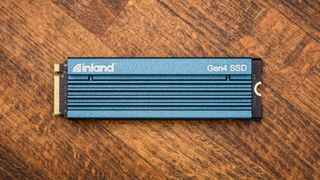
Specifications
Reasons to buy
Reasons to avoid
The Inland Gaming Performance Plus is a mature platform that performs well in the PS5, and the included heatsink means one less thing to worry about. It also comes in a great range of capacities, including 8TB, making it perfect for game libraries of any size. While it may not be fancy, this drive is a great value for PS5 and desktop gaming. While the SN850X and 990 Pro are faster, they’re also significantly more expensive.
Newer drives, like the Lexar NM790 and Crucial T500, are more power efficient, although these tend to tap out at 2TB or at most 4TB. Those drives are heatsink-optional, and while it’s true the Gaming Performance Plus comes sans heatsink in the Performance Plus, we think it’s worth investing in cooling for the PS5 for long-term use. This drive’s hardware provides the best performance consistency, and its easy availability is a plus.
Read: Inland Gaming Performance Plus SSD Review
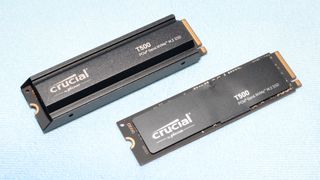
Specifications
Reasons to buy
Reasons to avoid
The Crucial T500 is a high-end PCIe 4.0 x4 NVMe SSD that dishes out speeds of up to 7.4 / 7.0 GB/s of read/write throughput along with up to 1.18 million IOPS. The 2TB model checks in at just over $100 (it comes without the heatsink, which costs an extra $23), while the 1TB with a heatsink weighs in at a mere $64. That 1TB drive is particularly attractive as a budget upgrade option.
The drive dishes out plenty of performance, and while it's not quite as fast in the PS5 read test as the top drives, it was basically just as fast in our real-world file copy tests. As noted in our Best SSD for PS5 article, the difference between the fastest and slowest SSDs in real-world gaming is incredibly slim, so the T500's price tag will draw in the value seekers.
The endurance ratings on the various T500 models are a bit lower than some of the competition, topping out at 1,200 TBW for the 2TB drive, but will you really completely fill and erase the drive 600 times while using it in a PS5? Probably not. You can also examine the Crucial P5 Plus as a similar-performing alternative that may save you a few dollars, depending on sales.
Read: Crucial T500 Review
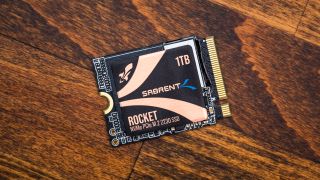
Specifications
Reasons to buy
Reasons to avoid
The Sabrent Rocket 2230 is a fast and efficient M.2 2230 drive designed for devices that need smaller PCIe SSDs, like the Steam Deck or Microsoft’s Surface Pro series. Such smaller drives are usually sold only with pre-built OEM machines. A retail option like the Rocket 2230 means that you can avoid second-hand drives that may lack reliable support and a warranty.
Retail 2TB M.2 2230 drives use slower QLC flash, although this is not all that detrimental in the Deck. It’s also possible to get the OEM WD SN740 with TLC up to 2TB, but it has a higher power draw and costs more than some QLC alternatives. This leaves the Rocket 2230 as the best overall drive for this segment, with good performance, efficiency, and capacity options, but make sure to compare pricing when buying.
The Rocket 2230 has good all-around performance and maintains a solid level of performance in sustained workloads. It is also quite efficient in our tests thanks to its blend of a newer PCIe 4.0 controller and 176-Layer NAND flash. You can get the same results with many M.2 2280 drives at a much lower cost, however. The drive is also currently limited to a peak capacity of 1TB, and product registration is required to get the full warranty. Still, it’s the best choice for certain machines, particularly the popular Steam Deck.
Read: Sabrent Rocket 2230 SSD Review
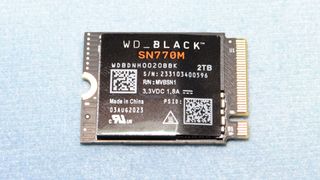
Specifications
Reasons to buy
Reasons to avoid
The WD Black SN770M is unique in that it offers 2TB of TLC NAND flash in the tiny M.2 2230 form factor in a single-sided design. This makes it optimal for use in the Steam Deck, ASUS ROG Ally, and other portable gaming/computing devices. Some of these can take double-sided drives or longer drives, but the most popular of them all - the Deck and Deck OLED - work best with this form factor. For a long time, it was only possible to get a drive with less-desirable QLC if you wanted 2TB, but with the SN770M, that compromise is no longer required.
This comes at a cost as the older hardware on the SN770M - which is the same as the popular M.2 2280 Black SN770 - pulls more power and puts out more heat. For regular gaming use, this wasn’t an issue in our testing. The difference in battery life is essentially negligible, and the drive is usually not pushed enough for its direct heat output to be an issue. Therefore, it offers the best baseline performance in this form factor for now, but QLC-based alternatives may be more affordable.
Read: WD Black SN770M Review
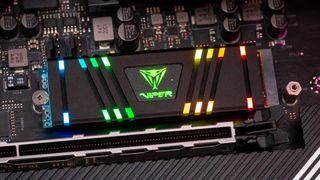
Specifications
Reasons to buy
Reasons to avoid
Patriot’s Viper VPR400 could be seen as the successor to their now-retired VPR100. The heatsink is essentially the same, as is the RGB. Patriot’s sync software works with ASRock, ASUS, Gigabyte, and MSI. In practice, enabling this mode does draw more power and produce more heat but neither should be a problem in a well-ventilated desktop case. Patriot backs all of this up with a 5-year, 800TBW-per-TB warranty.
Performance is good, as would be expected from a drive with InnoGrit’s IG5220 controller and Micron’s 176-layer TLC flash. While DRAM-less and not as fast as high-end PCIe 4.0 drives, this combination remains competitive and more than enough for most users. However, the aesthetics come at a price: the Viper VPR400 is very expensive for what it is. This is therefore a drive for the gamer who is willing to pay more for the perfect thematic build.
Read: Patriot Viper VPR400 Review
Best Workstation SSDs 2024
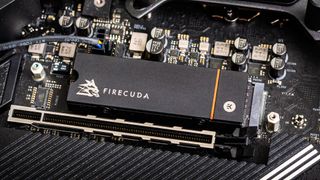
Specifications
Reasons to buy
Reasons to avoid
We know Optane’s DC P5800X is unearthly fast for workstation drives, but it has limited capacity and doesn’t come in the same efficient M.2 form factor. The FireCuda 530, on the other hand, is available in capacities of up to 4TB, comes in that small M.2 form factor, and delivers incredible sustained write speeds for a flash-based SSD. The FireCuda 530 is also only one of two drives in this class to currently support Phison’s I/O+ firmware for DirectStorage optimization.
Sporting Phison’s beastly, penta-core PS5018-E18 NVMe SSD controller and Micron’s fast 176-Layer TLC flash, the FireCuda 530 outperforms both the Samsung and WD across the board. And it comes backed by a better warranty and support service. However, its high performance, endurance, and data rescue support add quite a bit to pricing, making it a very premium buy targeted for the professional crowd rather than the average gamer.
Read: Seagate FireCuda 530 Review
Best NAS SSDs 2024
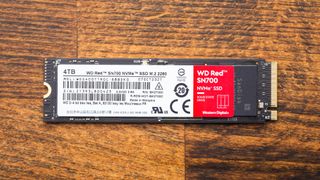
Specifications
Reasons to buy
Reasons to avoid
This drive is effectively an updated WD Black SN750, which was known for its consistent performance and good efficiency. However, it’s tailored for NAS usage, making it a nice choice for an NVMe NAS SSD, especially when coupled with up to 4TB of TLC flash.
The WD Red SN700 doesn’t offer anything special for the general user but is great for use in a NAS. The underlying technology is also starting to show its age, but that maturity is important for critical storage systems like a NAS where performance isn’t as much of a focus. The WD Red SN700 also doesn’t have power loss protection, which isn’t surprising as this drive isn’t for an enterprise application. However, the warranty and rated endurance are strong, making this a good buy for the right usage, which is in a NAS.
Read: WD Red SN700 SSD Review
Best SATA SSDs 2024
You can get a SATA drive in the M.2 form factor, but most SATA drives are 2.5-inch models, which allows them to drop into the same bays that hold laptop hard drives. SATA drives are the cheapest.
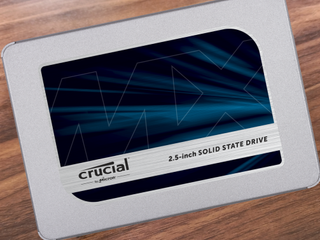
Specifications
Reasons to buy
Reasons to avoid
If you don’t want to dish out big bucks on something in the NVMe flavor but still want strong SATA performance, the MX500 is a great choice. As an alternative to the Samsung 860 EVO, it offers similar performance and has a strong history of reliability. Usually priced to sell, the MX500 is a top value at any capacity you need.
Read: Crucial MX500 Review
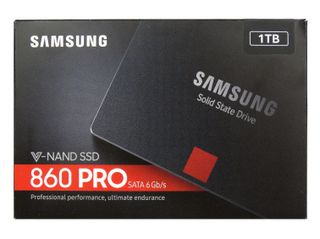
Specifications
Reasons to buy
Reasons to avoid
Restrained by the SATA interface, but still need the absolute highest endurance and performance you can get? As the pinnacle of SATA performance inside and out, Samsung’s 860 PRO is the SSD to buy.
Like the Samsung 970 PRO, the 860 PRO uses Samsung’s 64L MLC V-NAND, which helps propel it to the top of the charts in our rounds of benchmarking and makes for some incredible endurance figures. You can get capacities up to 4TB, and endurance figures can be as high as 4,800 TBW. But with prices that are triple that of your typical mainstream SATA SSD, the 860 PRO is mainly for businesses with deep pockets.
Read: Samsung 860 Pro Review
Finding Discounts on the Best SSDs in 2024
Whether you're shopping for one of the best SSDs or one that didn't quite make our list, you may find savings by checking out the latest Crucial promo codes, Newegg promo codes, Amazon promo codes, Corsair coupon codes, Samsung promo codes or Micro Center coupons.
MORE: Best External SSDs and Hard Drives
MORE: How We Test HDDs And SSDs
MORE: All SSD Content
Stay on the Cutting Edge
Join the experts who read Tom's Hardware for the inside track on enthusiast PC tech news — and have for over 25 years. We'll send breaking news and in-depth reviews of CPUs, GPUs, AI, maker hardware and more straight to your inbox.

Paul Alcorn is the Managing Editor: News and Emerging Tech for Tom's Hardware US. He also writes news and reviews on CPUs, storage, and enterprise hardware.
- Shane DowningFreelance Reviewer
-
abryant Archived comments are found here: http://www.tomshardware.com/forum/id-3711120/ssds.htmlReply -
LordConrad About the MX500... "but the 500GB looks really good at just $139.99"Reply
You might want to double check prices when cutting and pasting. -
Peter Martin i can get an mx500 500GB for 90 bucks on amazon, they are fantastic ssd, the larger the better, get all that you can affordReply -
dannyboy3210 SX8200 480GB looks unbelievably expensive in the states. It goes for $150 CAD up here: https://www.canadacomputers.com/product_info.php?cPath=179_1229_1296&item_id=123218Reply -
WildCard999 I would think the Samsung 860 EVO 500gb would have grabbed the spot for best SATA as you can get it for $99 (500gb) and it's quite fast. I doubt the pro is fast enough to justify the cost over the EVO version.Reply
http://ssd.userbenchmark.com/Compare/Samsung-860-Evo-1TB-vs-Samsung-860-Pro-1TB/m423831vsm434505 -
Jsimenhoff Thanks for bringing this to our attention. It looks like the wires got crossed on our pricing widget. We're implementing a fix. Stand by.Reply -
rapidwolve Dannyboy3210 Actually that SX8200 is now only $130CDN @ Canada ComputersReply
https://www.canadacomputers.com/product_info.php?cPath=179_1229_1296&item_id=123218 -
Onus I recently ordered a 1TB 2.5" WD Blue SSD for ~$139 on a Shellshocker. Hopefully it arrives soon!Reply -
WildCard999 Reply21394321 said:I recently ordered a 1TB 2.5" WD Blue SSD for ~$139 on a Shellshocker. Hopefully it arrives soon!
Was that the M.2 or the SATA version?
